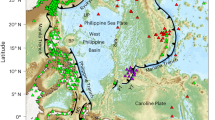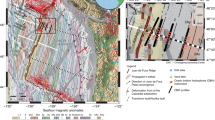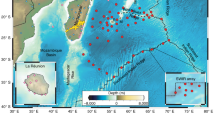Abstract
Seismic tomography has been used to infer that some descending slabs of oceanic lithosphere plunge deep into the Earth's lower mantle1,2. The fate of these slabs has remained unresolved, but it has been postulated that their ultimate destination is the lowermost few hundred kilometres of the mantle, known as the D″ region. Relatively cold slab material may account for high seismic velocities imaged in D″ beneath areas of long-lived plate subduction, and for reflections from a seismic velocity discontinuity just above the anomalously high wave speed regions3,4. The D″ discontinuity itself is probably the result of a phase change in relatively low-temperature magnesium silicate perovskite5,6. Here, we present images of the D″ region beneath the Cocos plate using Kirchhoff migration of horizontally polarized shear waves, and find a 100-km vertical step occurring over less than 100 km laterally in an otherwise flat D″ shear velocity discontinuity. Folding and piling of a cold slab that has reached the core–mantle boundary, as observed in numerical and experimental models, can account for the step by a 100-km elevation of the post-perovskite phase boundary due to a 700 °C lateral temperature reduction in the folded slab. We detect localized low velocities at the edge of the slab material, which may result from upwellings caused by the slab laterally displacing a thin hot thermal boundary layer.
This is a preview of subscription content, access via your institution
Access options
Subscribe to this journal
Receive 51 print issues and online access
$199.00 per year
only $3.90 per issue
Buy this article
- Purchase on Springer Link
- Instant access to full article PDF
Prices may be subject to local taxes which are calculated during checkout




Similar content being viewed by others
References
Grand, S. P., van der Hilst, R. D. & Widiyantoro, S. Global seismic tomography: a snapshot of convection in the Earth. GSA Today 7, 1–7 (1997)
Grand, S. P. Mantle shear-wave tomography and the fate of subducted slabs. Phil. Trans. R. Soc. Lond. A 360, 2475–2491 (2002)
Lay, T. & Garnero, E. J. in The State of the Planet: Frontiers and Challenges in Geophysics (eds Sparks, R. S. J. & Hawkesworth, C. J.) 25–41 (Geophysical Monograph 150, American Geophysical Union, Washington DC, 2004)
Wysession, M. E., et al. in The Core-Mantle Boundary Region (eds Gurnis, M., Wysession, M. E., Knittle, E. & Buffett, B. A.) 273–298 (Geodynamics Series 28, American Geophysical Union, Washington DC, 1998)
Murakami, M., Hirose, K., Kawamura, K., Sata, N. & Ohishi, Y. Post-perovskite phase transition in MgSiO3 . Science 304, 855–858 (2004)
Lay, T. et al. Multidisciplinary impact of the deep mantle phase transition in perovskite structure. Eos 86, 1, 5 (2005)
Masters, G., Laske, G., Bolton, H. & Dziewonski, A. M. in Earth's Deep Interior: Mineral Physics and Tomography from the Atomic to the Global Scale, (eds Karato, S., Forte, A. M., Liebermann, R. C., Masters, G. & Stixrude, L.) 63–87 (American Geophysical Union, Washington DC, 2000)
Wen, L., Silver, P., James, D. & Kuehnel, R. Seismic evidence for a thermo-chemical boundary at the base of the Earth's mantle. Earth Planet. Sci. Lett. 189, 141–153 (2001)
Ni, S. & Helmberger, D. V. Ridge-like lower mantle structure beneath South Africa. J. Geophys. Res. 108, doi:10.1029/2001JB001545 (2003)
Oganov, A. R. & Ono, S. Theoretical and experimental evidence for a post-perovskite phase of MgSiO3 in Earth's D″ layer. Nature 430, 445–448 (2004)
Lay, T., Garnero, E. J. & Russell, S. A. Lateral variation of the D” discontinuity beneath the Cocos Plate. Geophys. Res. Lett. 31, doi: 10.1029/2004GL020300 (2004)
Reasoner, C. & Revenaugh, J. Short-period P wave constraints on D″ reflectivity. J. Geophys. Res. 104, 955–961 (1999)
Thomas, C., Garnero, E. J. & Lay, T. High-resolution imaging of lowermost mantle structure under the Cocos Plate. J. Geophys. Res. 109, doi: 10.1029/2004JB003013 (2004)
Ding, X. & Helmberger, D. V. Modeling D″ structure beneath Central America with broadband seismic data. Phys. Earth Planet. Inter. 101, 245–270 (1997)
Rokosky, J. M., Lay, T., Garnero, E. J. & Russell, S. A. High-resolution investigation of shear wave anisotropy in D″ beneath the Cocos Plate. Geophys. Res. Lett. 31, L07605, doi: 10.1029/2003GL018902 (2004)
Lay, T. & Young, C. J. Imaging scattering structures in the lower mantle by migration of long-period S waves. J. Geophys. Res. 101, 20023–20040 (1996)
Revenaugh, J. A scattered-wave image of subduction beneath the Transverse Ranges, California. Science 268, 1888–1892 (1995)
Thomas, C., Weber, M., Wicks, C. W. & Scherbaum, F. Small scatterers in the lower mantle observed at German broadband arrays. J. Geophys. Res. 104, 15073–15088 (1999)
Kito, T., Krüger, F. & Negishi, H. Seismic heterogeneous structure in the lowermost mantle beneath the southwestern Pacific. J. Geophys. Res. 109, B09304, doi: 10.1029/2003JB002677 (2004)
Lay, T. & Helmberger, D. V. A lower mantle S-wave triplication and the shear velocity structure of D. Geophys. J. R. Astron. Soc. 75, 799–837 (1983)
Dziewonski, A. M. & Anderson, D. L. Preliminary reference Earth model. Phys. Earth Planet. Inter. 25, 297–356 (1981)
Megnin, C. & Romanowicz, B. The three-dimensional shear velocity structure of the mantle from the joint inversion of body, surface, and higher mode waveforms. Geophys. J. Int. 143, 709–728 (2000)
Ritsema, J. & Van Heijst, H. J. Seismic imaging of structural heterogeneity in Earth's mantle: evidence for large-scale mantle flow. Sci. Prog. (New Haven) 83, 243–259 (2000)
Hung, S.-H., Garnero, E. J., Chiao, L.-Y., Kuo, B.-Y. & Lay, T. Finite-frequency tomography of D″ shear velocity heterogeneity beneath the Caribbean. J. Geophys. Res. 110, B07305, doi: 10.1029/2004JB003373 (2005)
Tan, E., Gurnis, M. & Han, L. Slabs in the lower mantle and their modulation of plume formation. Geochem. Geophys. Geosyst. 3, 1067, doi: 10.1029/2001GC000238 (2002)
Hernlund, J. W., Thomas, C. & Tackley, P. J. A doubling of the post-perovskite phase boundary and structure of the Earth's lowermost mantle. Nature 434, 882–886 (2005)
Flores, C. & Lay, T. The trouble with seeing double. Geophys. Res. Lett. 32, L24305, doi: 10.1029/2005GL024366 (2005)
Acknowledgements
M. Thorne provided three-dimensional finite difference synthetics for versions of our step discontinuity structure. We also thank Q. Williams for discussions.
Author information
Authors and Affiliations
Corresponding author
Ethics declarations
Competing interests
Reprints and permissions information is available at npg.nature.com/reprintsandpermissions. The authors declare no competing financial interests.
Supplementary information
Supplementary Figures
This file contains Supplementary Figures 1–12. (PDF 8109 kb)
Supplementary Figure Legends
This file contains legends to accompany the above Supplementary Figures. (DOC 39 kb)
Rights and permissions
About this article
Cite this article
Hutko, A., Lay, T., Garnero, E. et al. Seismic detection of folded, subducted lithosphere at the core–mantle boundary. Nature 441, 333–336 (2006). https://doi.org/10.1038/nature04757
Received:
Accepted:
Issue Date:
DOI: https://doi.org/10.1038/nature04757
This article is cited by
-
Links between large igneous province volcanism and subducted iron formations
Nature Geoscience (2023)
-
Waveform inversion for 3-D S-velocity structure of D′′ beneath the Northern Pacific: possible evidence for a remnant slab and a passive plume
Earth, Planets and Space (2016)
-
Restoration of clipped seismic waveforms using projection onto convex sets method
Scientific Reports (2016)
-
FeO2 and FeOOH under deep lower-mantle conditions and Earth’s oxygen–hydrogen cycles
Nature (2016)
-
Characterization of the D″ beneath the Galapagos Islands using SKKS and SKS waveforms
Earthquake Science (2011)
Comments
By submitting a comment you agree to abide by our Terms and Community Guidelines. If you find something abusive or that does not comply with our terms or guidelines please flag it as inappropriate.



